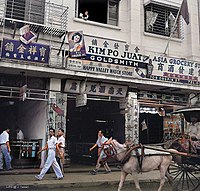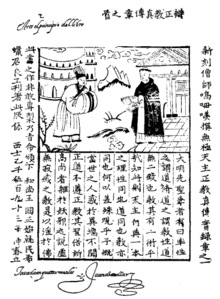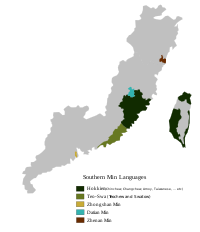lingvo.wikisort.org - Language
Philippine Hokkien[lower-alpha 5] is a dialect of the Hokkien language of the Southern Min branch, primarily spoken vernacularly by Chinese Filipinos in the Philippines, where it serves as the local Chinese lingua franca,[4] primarily spoken as an oral language, within the overseas Chinese community in the Philippines and acts as the heritage language of a majority of Chinese Filipinos.[5] The use of Hokkien in the Philippines is influenced by Philippine Spanish,[6][7] Filipino (Tagalog) and Philippine English.[1]
| Philippine Hokkien | |||||||||||||
|---|---|---|---|---|---|---|---|---|---|---|---|---|---|
| Traditional Chinese | 咱人話 / 咱儂話 | ||||||||||||
| Tâi-lô | Lán-nâng-uē / Lán-lâng-uē / Nán-nâng-uē | ||||||||||||
| Literal meaning | Our People's Speech | ||||||||||||
| |||||||||||||
| Alternative Name (Philippine Hokkien) | |||||||||||||
| Traditional Chinese | 菲律賓福建話 | ||||||||||||
| Tâi-lô | Hui-li̍p-pin Hok-kiàn-uē | ||||||||||||
| Literal meaning | Philippine Hokkien Speech | ||||||||||||
| |||||||||||||
| Alternative Name (Philippine Min Nan) | |||||||||||||
| Traditional Chinese | 菲律賓閩南話 | ||||||||||||
| Tâi-lô | Hui-li̍p-pin Bân-lâm-uē | ||||||||||||
| Literal meaning | Philippine Southern Min Speech | ||||||||||||
| |||||||||||||
| This article is part of a series on the |
| Culture of the Philippines |
|---|
 |
| Society |
|
| Arts and literature |
|
| Other |
|
| Symbols |
|
Philippines portal |
This article needs additional citations for verification. (June 2016) |
| Philippine Hokkien | |
|---|---|
| 咱人話 / 咱儂話 Lán-nâng-uē / Lán-lâng-uē / Nán-nâng-uē (Tâi-lô) Lán-nâng-ōe / Lán-lâng-ōe / Nán-nâng-ōe (POJ) | |
 | |
| Native to | Philippines |
| Region | Metro Manila, Metro Cebu, Metro Davao, Zamboanga City, Cagayan de Oro, Metro Bacolod, Iloilo, Baguio, Sulu, Bohol, Leyte, Pangasinan, Pampanga, Tarlac, Vigan, Laoag, Laguna, Rizal, Lucena, Naga, and other parts of the Philippines |
Language family | Sino-Tibetan
|
Writing system |
|
| Language codes | |
| ISO 639-3 | – |
| Glottolog | None |
| Linguasphere | 79-AAA-jek |
Terminology
The term Philippine Hokkien is used when differentiating the variety of Hokkien spoken in the Philippines from those spoken in China, Taiwan, Malaysia, Singapore, Indonesia, and other Southeast Asian countries.[8][2]
Historically, it was also known in Philippine English, Filipino (Tagalog), and other Philippine languages as Fookien[1] or Fukien[9] across the country, derived from the Chinese postal romanization of the Nanjing court dialect Mandarin reading of Fujian province in China, such as in the old newspaper, The Fookien Times.
The endonym used by speakers of the dialect itself or the Hokkien language in general though is typically, Chinese: 咱人話 / 咱儂話; Pe̍h-ōe-jī: Lán-nâng-ōe / Lán-lâng-ōe / Nán-nâng-ōe; Tâi-lô: Lán-nâng-uē / Lán-lâng-uē / Nán-nâng-uē.[1]
Sociolinguistics
Only 12.2% of all ethnic Chinese in the Philippines have a variety of Chinese as their mother tongue. Nevertheless, the vast majority (77%) still retain the ability to understand and speak Hokkien as a second or third language.[10]
History

From the late 16th century to the early 17th century, Spanish friars in the Philippines, such as the Dominican Order specifically in Manila, produced materials documenting the Hokkien varieties spoken by the Chinese trading community who had settled there in the late 16th century:[11][6]
- Doctrina Christiana en letra y lengua China (1593), a Hokkien translation of the Doctrina Christiana.[12][7][13][14]
- Dictionario Hispanico Sinicum (1604), a Spanish-Hokkien dictionary, giving equivalent words, but not definitions.[15]
- Bocabulario de la lengua sangleya (c. 1617), a Spanish-Hokkien dictionary, with definitions.
- Arte de la Lengua Chiõ Chiu (1620), a grammar written by a Spanish missionary in the Philippines.[16]
These texts appear to record a Zhangzhou dialect of Hokkien, from the old port of Yuegang (modern-day Haicheng, an old port that is now part of Longhai),[17] which Klöter (2011) calls as Early Manila Hokkien (EMH).[6]
However by 1873, Carstairs Douglas writes in his dictionary that [18]
Singapore and the various Straits Settlements [such as Penang and Malacca], Batavia [Jakarta] and other parts of the Dutch possessions [Indonesia], are crowded with emigrants, especially from the Chang-chew [Zhangzhou] prefecture; Manila and other parts of the Philippines have great numbers from Chin-chew [Quanzhou], and emigrants are largely scattered in like manner in Siam [Thailand], Burmah [Myanmar], the Malay Peninsula [Peninsular Malaysia], Cochin China [Southern Vietnam, Cambodia, Laos], Saigon [Ho Chi Minh City, Vietnam], &c. In many of these places there is also a great mixture of emigrants from Swatow [Shantou].
— Carstairs Douglas, Extent of the Amoy Vernacular, and its Sub-division into Dialects: Colonization And Emigration, Chinese–English Dictionary of the Vernacular or Spoken Language of Amoy
By 1941, Vicente Lim publishes a dictionary in Manila, titled "Chinese-English-Tagalog-Spanish Business conversation and social contact with Amoy pronunciation".[19]
Education
During the late 20th century, despite Standard Chinese (Mandarin) taking the place as the usual Chinese class subject taught in Chinese Filipino schools as the topic of study, some schools had Chinese teachers that used Amoy Hokkien as medium of instruction in order to teach Mandarin Chinese to native-Hokkien-speaking Chinese Filipino students, but decades later around the Marcos Era, regulations became stricter and the medium of instruction for teaching Standard Chinese (Mandarin) in Chinese classes shifted from Amoy Hokkien Chinese to purely Mandarin Chinese (or in some schools to English). Also, due to the increased rural to urban migration of Chinese Filipinos, Chinese Filipino schools in urban areas increased but those in the provinces gradually declined, some closing down or some turning into ordinary Philippine schools, where some tried to preserve their "Chinese" characteristic by instead teaching Hokkien as their Chinese class subject, deeming it as more practical in the Philippine-Chinese setting.[20]
As of 2019[update], the Ateneo de Manila University, under their Chinese Studies Programme, offers Hokkien 1 (Chn 8) and Hokkien 2 (Chn 9) as electives.[21] Chiang Kai Shek College offers Hokkien classes in their CKS Language Center.[22]
Linguistic features

Philippine Hokkien is largely derived from the Jinjiang dialect of Quanzhou but has possibly also absorbed influences from the Amoy dialect of Xiamen and Nan'an dialects of Quanzhou.[23][24]
Although Philippine Hokkien is generally mutually comprehensible especially with other Quanzhou Hokkien variants, including Singaporean Hokkien and Quanzhou-based Taiwanese Hokkien variants, the local vocabulary, tones, and Filipino or Philippine Spanish and English loanwords as well as the extensive use of contractions and colloquialisms (even those which are now unused or considered archaic or dated in China) can result in confusion among Hokkien speakers from outside of the Philippines.[citation needed]
Some terms have been shortened into one syllable. Examples include:[19]
- dī-tsa̍p/lī-tsa̍p (二十) > dia̍p/lia̍p (廿 / 廾): twenty; 20 (same format for 20–29, i.e. 二十一[21] is "dia̍p-it" 廿一)
- saⁿ-tsa̍p (三十) > sap (卅): thirty; 30 (same format for 30–39, i.e. 三十二[32] is "sa̍p-dī" 卅二)
- sì-tsa̍p (四十) > siap (卌): forty; 40 (same format for 40–49, i.e. 四十三[43] is "siap-saⁿ" 卌三)
Vocabulary
Philippine Hokkien, like other Southeast Asian variants of Hokkien (e.g. Singaporean Hokkien, Penang Hokkien, Johor Hokkien and Medan Hokkien), has borrowed words from other languages spoken locally, specifically Spanish, Tagalog and English. Examples include:[1][19]
- manis /ma˧ nis˥˧/: "corn", either from Spanish maíz or Tagalog mais
- lettuce 菜 /le˩ tsu˧ tsʰai˥˩/: "lettuce", from either English lettuce or Spanish lechuga + Hokkien 菜 (chhài, "vegetable")
- pamkin /pʰam˧ kʰin˥/: "pumpkin", from English pumpkin
- ka kaó: "cocoa", either from Spanish cacao or Tagalog kakaw
- kape: "coffee", either from Spanish café or Tagalog kape
- pà-chî: "potato", either from Spanish patata or Tagalog patatas + Hokkien 薯 (chî, "potato")
- kam-á-tit: "tomato", either from Tagalog kamatis or directly from Spanish tomate
- sap-bûn: "soap", from Early Modern Spanish jabón or Tagalog sabon
Philippine Hokkien also has some vocabulary that is unique to it compared to other varieties of Hokkien:[1][19]
- 車頭 /tsʰia˧ tʰau˩˧/: "chauffeur"
- 山猴 /suã˧ kau˩˧/: "country bumpkin"
- 義山 /ɡi˩ san˧/: "cemetery" (used in the sign for Manila Chinese Cemetery)
- 霸薯 /pa˥˥˦ tsi˨˦/: "potato"
- 麵頭 /bin˩ tʰau˨˦/: "bread"
- 病厝 /pĩ˩ tsʰu˦˩/: "hospital"
Hokaglish
Hokaglish is code-switching involving Philippine Hokkien, Tagalog and English. Hokaglish shows similarities to Taglish (mixed Tagalog and English), the everyday mesolect register of spoken Filipino language within Metro Manila and its environs.[8]
Both ways of speaking are very common among Chinese Filipinos, who tend to code-switch these languages in everyday conversation, where it can be observed that older generations typically use the Hokkien Chinese sentence structure base while injecting English and Tagalog words while the younger ones use the Filipino/Tagalog sentence structure as the base while injecting the few Hokkien terms they know in the sentence. The latter therefore, in a similar sense with Taglish using Tagalog grammar and syntax, tends to code-mix via conjugating the Hokkien terms the way they do for Filipino/Tagalog words.[25]
See also
- Hokkien architecture
- Hokkien culture
- Hokkien media
- Hoklo people
- Holopedia
- Mandarin Chinese in the Philippines
- Medan Hokkien
- Penang Hokkien
- Pe̍h-ōe-jī
- Singapore Hokkien
- Southern Malaysia Hokkien
- Speak Hokkien Campaign
- Taiwanese Hokkien
- Taiwanese Romanization System
- Written Hokkien
Notes
- Official Language in the Philippines
- National & Co-official Language in the Philippines
- "Chinese" (Mandarin) as taught in Chinese Filipino schools in the Philippines
- Historical Official Language since the Spanish Colonial Era of the Philippines
- also known as Lannang-Oe (Chinese: 咱人話 / 咱儂話; Pe̍h-ōe-jī: Lán-nâng-ōe / Lán-lâng-ōe / Nán-nâng-ōe; lit. 'Our People's Speech'),[1][2] Fukien,[3] and Fookien[1]
References
- Tsai, Hui-Ming 蔡惠名 (2017). Fēilǜbīn zán rén huà (Lán-lâng-uē) yánjiū 菲律賓咱人話(Lán-lâng-uē)研究 [A Study of Philippine Hokkien Language] (PhD thesis) (in Chinese). National Taiwan Normal University.
- Lin, Philip T. (2015). Taiwanese Grammar: A Concise Reference. Greenhorn Media. ISBN 978-0-9963982-1-3.
- Chan Yap, Gloria (1980). Hokkien Chinese Borrowings in Tagalog. Canberra: Department of Linguistics, Research School of Pacific Studies, Australian National University. ISBN 9780858832251.
- Go, Josiah (April 17, 2017). "Chinese education redefined". Philippine Daily Inquirer. Retrieved November 22, 2021.
- Palanca, Ellen H. (2002). "A Comparative Study of Chinese Education in the Philippines and Malaysia*" (PDF). Asian Studies. 38 (2): 31 – via Asian Studies: Journal of Critical Perspectives on Asia.
- Klöter (2011)
- Van der Loon (1966)
- Gonzales, Wilkinson Daniel Wong (2016). Exploring Trilingual Code-Switching: The Case of 'Hokaglish' (PDF). The 26th Annual Meeting of the Southeast Asian Linguistics Society, Manila, Philippines.
- Chan Yap, Gloria (1980). Hokkien Chinese Borrowings in Tagalog. Canberra: Department of Linguistics, Research School of Pacific Studies, Australian National University. ISBN 9780858832251.
- See, Teresita Ang (1997). The Chinese in the Philippines: Problems and Perspectives. Manila: Kaisa Para Sa Kaunlaran. p. 57.
- Chappell, Hilary; Peyraube, Alain (2006). "The Analytic Causatives of Early Modern Southern Min in Diachronic Perspective". In Ho, D.-a.; Cheung, S.; Pan, W.; Wu, F. (eds.). Linguistic Studies in Chinese and Neighboring Languages. Taipei: Institute of Linguistics, Academia Sinica. pp. 973–1011.
- Yue, Anne O. (1999). "The Min Translation of the Doctrina Christiana". Contemporary Studies on the Min Dialects. Journal of Chinese Linguistics Monograph Series 14. Chinese University Press. pp. 42–76. JSTOR 23833463.
- Cobo, Juan (1593). Doctrina Christiana en letra y lengua China, compuesta por los padres ministros de los Sangleyes, de la Orden de Sancto Domingo (in Spanish). Manila – via UST Miguel de Benavidez Library.
- Cobo, Juan (1593). Doctrina Christiana en letra y lengua China, compuesta por los padres ministros de los Sangleyes, de la Orden de Sancto Domingo (in Spanish). Manila – via ip194097.ntcu.edu.tw.
- Zulueta, Lito B. (February 8, 2021). "World's Oldest and Largest Spanish-Chinese Dictionary Found in UST". Philippine Daily Inquirer. Retrieved February 8, 2021.
{{cite news}}: CS1 maint: url-status (link) - Mançano, Melchior; Feyjoó, Raymundo (1620). Arte de la Lengua Chiõ Chiu – via Universitat de Barcelona.
- Van der Loon (1967)
- Douglas, Carstairs (1899). "Extent of the Amoy Vernacular, and its Sub-division into Dialects.". Chinese-English dictionary of the vernacular or spoken language of Amoy (in English & Amoy Hokkien). London: Presbyterian Church of England. p. 610.
{{cite book}}: CS1 maint: unrecognized language (link) - Lim, Vicente (1941). Chinese-English-Tagalog-Spanish Business conversation and social contact with Amoy pronunciation (PDF). Manila: Poc Bon Book Co.
- Palanca, Ellen H. (2002). "A Comparative Study of Chinese Education in the Philippines and Malaysia*" (PDF). Asian Studies. 38 (2): 55 – via Asian Studies: Journal of Critical Perspectives on Asia.
- "Minor in Chinese Studies". Ateneo de Manila University. 13 March 2013. Retrieved 4 November 2019.
- "CKS Language Center". Chiang Kai Shek College. Retrieved 4 November 2019.
- Cai, Huiming 蔡惠名; Wang, Guilan 王桂蘭 (2011). "Fēilǜbīn Fújiànhuà chūbù diàochá chéngguǒ" 菲律賓福建話初步調查成果 [Preliminary Research Results on Philippine Hokkien]. Hǎiwēng Táiyǔ wénxué jiàoxué jìkān 海翁台語文學教學季刊 (in Chinese) (11): 52. doi:10.6489/HWTYWHCHCK.201103.0046.
- Gonzales, Wilkinson Daniel Ong Wong (2018). Philippine Hybrid Hokkien as a Postcolonial Mixed Language: Evidence from Nominal Derivational Affixation Mixing (M.A. thesis). National University of Singapore.
- Palanca, Ellen H. (2002). "A Comparative Study of Chinese Education in the Philippines and Malaysia*" (PDF). Asian Studies. 38 (2): 32 – via Asian Studies: Journal of Critical Perspectives on Asia.
Further reading
- Klöter, Henning (2011). The Language of the Sangleys: A Chinese Vernacular in Missionary Sources of the Seventeenth Century. Brill. ISBN 978-90-04-18493-0. - An analysis and facsimile of the Arte de la Lengua Chio-chiu (1620), the oldest extant grammar of Hokkien.
- Doctrina Christiana en letra y lengua china (in Spanish). Manila. 1607 – via Biblioteca Digital Hispánica. – Hokkien translation of the Doctrina Christiana.
- Arte de la Lengua Chio-chiu (in Spanish). Manila. 1620 – via Biblioteca Patrimonial Digital de la Universitat de Barcelona. – A manual for learning Hokkien written by a Spanish missionary in the Philippines.
- Van der Loon, Piet (1966). "The Manila Incunabula and Early Hokkien Studies, Part 1" (PDF). Asia Major. New Series. 12: 1–43.
- Van der Loon, Piet (1967). "The Manila Incunabula and Early Hokkien Studies, Part 2" (PDF). Asia Major. New Series. 13: 95–186.
На других языках
- [en] Philippine Hokkien
[ru] Лань-нан
Лань-нан (филиппинский хок-кьень, филиппинский южноминьский, филиппинский фуцзяньский) – один из диалектов ветви миньтай южноминьского языка , распространённый среди этнических китайцев на Филиппинах.Другой контент может иметь иную лицензию. Перед использованием материалов сайта WikiSort.org внимательно изучите правила лицензирования конкретных элементов наполнения сайта.
WikiSort.org - проект по пересортировке и дополнению контента Википедии

